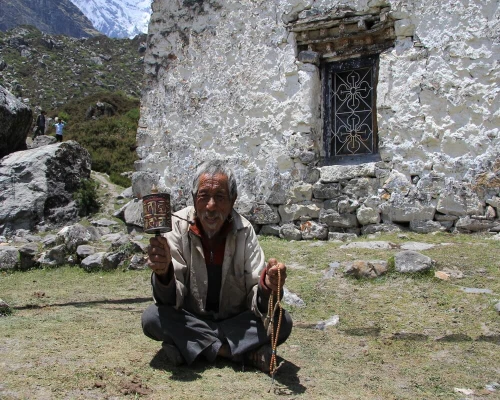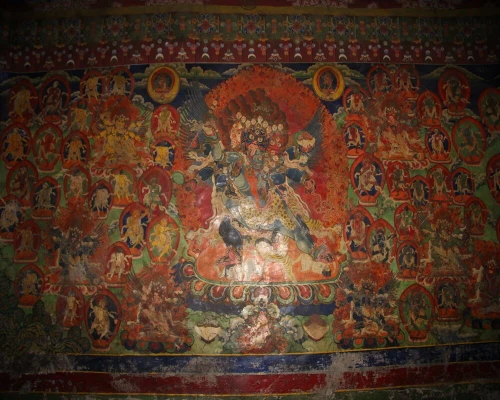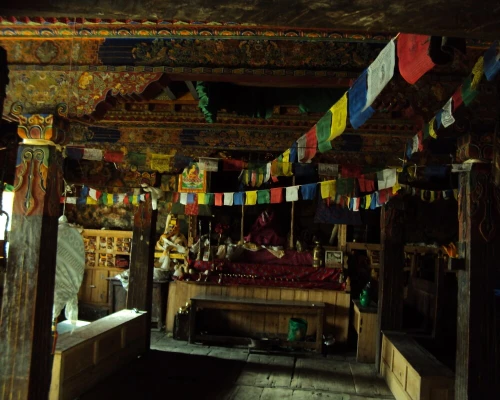Tamang Heritage Trail offers a unique cultural experience, allowing trekkers to immerse themselves in the rich heritage and traditions of the Tamang people. As you trek through the Tamang villages, you'll have the opportunity to interact with the locals, learn about their ancient customs, and gain insight into their way of life. The trail takes you through terraced green farmland, where the Tamang people practice agriculture and cultivate crops such as corn, millet, and potatoes. The picturesque landscapes, dotted with traditional houses and monasteries, provide a glimpse into the daily lives of the Tamang community.
The region is also known for its dense forests, including rhododendron and bamboo forests, which add to the natural beauty of the area. As you ascend higher, you'll be rewarded with breathtaking views of the Langtang Himalayas, including peaks like Langtang Lirung, Ganesh Himal, and Dorje Lakpa.
By choosing to trek the Tamang Heritage Trail, you not only get to enjoy the stunning scenery and cultural experiences but also contribute to the sustainable development of the local Tamang communities. The income generated from tourism helps uplift their livelihoods and supports various community projects. Overall, the Tamang Heritage Trail is a perfect blend of natural beauty, cultural exploration, and responsible tourism, offering a memorable and rewarding trekking experience in Nepal.
The Tamang Heritage Trail Trekking is definitely one of the handy trekking regions with a spectacularly headed route formation
- Embark on one of the classic cultural hikes, the Tamang Heritage Trail, and immerse yourself in the local Tamang community. Experience their unique lifestyle, traditions, and warm hospitality as you interact with the locals and learn about their rich cultural heritage.
- Marvel at the breathtaking views of the Gosaikund range, Langtang Himalayas, and the Ganesh Himal throughout your trek. The panoramic vistas of snow-capped peaks, pristine valleys, and lush landscapes will leave you awe-inspired and connected to the beauty of the Himalayas.
- Enjoy a memorable stay in Briddim, a vintage village where you can experience traditional Tamang accommodation. Immerse yourself in the rustic charm of the village, interact with the locals, and gain insights into their daily lives and customs.
- After a day of trekking, indulge in the rejuvenating hot spring waters of Tatopani. Soak in the natural thermal baths and let the warm waters relax your muscles and revitalize your body.
- The Tamang Heritage Trail offers a unique blend of cultural immersion, stunning mountain scenery, and natural wonders, making it a truly enriching and memorable trekking experience.
Tamang Heritage Trek has many appeals for nomads
The 9 day Tamang Heritage Trek offers a unique cultural experience, allowing you to immerse yourself in the mountainous beauty and rich heritage of the Tamang people. The Tamang community originated from Tibetan tribes as pony traders and settled in the region several hundred years ago. Despite being marginalized in Nepalese history, they hold a significant part of the country's heritage.
The trek takes you through unexplored areas of the Langtang National Park, where you can explore Tamang small towns like Galang and Briddim. The trek offers stunning views of forests, meadows, and alpine terrain, as well as glimpses of peaks like Langtang Lirung, Ganesh Himal, Jugal Himal, and Manaslu Massif.
During the trek, you'll also have the opportunity to learn about Tibetan history and culture, witness the trading path between Nepal and Tibet, and experience the local way of life. The Tamang people follow Buddhism and rely on agriculture for their livelihood, cultivating various grains and vegetables. Their homes are adorned with beautiful wood carvings, and their colorful clothing adds to the vibrant atmosphere. The trek also includes highlights like the Tamang Hospital, where you can experience a homestay in Birddim, and the Kyanjing Gomba, a narrow valley with breathtaking views at an altitude of 3900m.
The Best seasons to offer
Indeed, the best seasons to undertake the Tamang Heritage Trail trek are spring (March-May) and autumn (September-November). During these seasons, the weather is generally stable and favorable for trekking, with clear skies, mild temperatures, and little rainfall.
In the spring season, the trail comes alive with vibrant rhododendron blooms and lush greenery. The weather gradually becomes warmer, making it pleasant for trekking. This is also a great time for birdwatching as many migratory birds return to the region.
Autumn, on the other hand, offers clear skies and excellent visibility, providing breathtaking views of the surrounding mountains. The weather is cooler compared to the spring season, making it comfortable for trekking during the day and enjoying cozy evenings.
Winter (December-February) is also a viable option for the Tamang Heritage Trail, as the altitudes are not excessively high. Although temperatures can drop, the trail is generally less crowded, offering a more serene experience. It's important to pack warm clothing and appropriate gear to combat the cold weather.
Summer (June-August) is the monsoon season in Nepal, and the Langtang region receives a significant amount of rainfall. Trekking during this time can be challenging due to slippery trails, leeches, and limited mountain views. However, the landscape becomes incredibly lush, and the region is less crowded.
Ultimately, the choice of the best season depends on personal preferences and priorities. Spring and autumn are generally considered the prime seasons for the Tamang Heritage Trail due to their favorable weather conditions and optimal trekking experiences.
Experience natural hot springs along the trek
The Langtang region indeed offers the opportunity to experience natural hot springs along the trek. These hot springs are a natural wonder and provide a refreshing and therapeutic experience for trekkers. Taking a dip in the hot springs can help soothe tired muscles and provide relief from any skin ailments.
The presence of natural hot springs adds an extra dimension to the trek, allowing trekkers to connect with nature in a unique way. It is a wonderful opportunity to relax and rejuvenate amidst the breathtaking landscapes of the Langtang region.
As you enjoy the panoramic views of the mountains, you can also immerse yourself in the natural hot springs, making the trek even more rewarding. The memories and experiences gained from this rare highlight will undoubtedly make your trip worth every penny spent.






